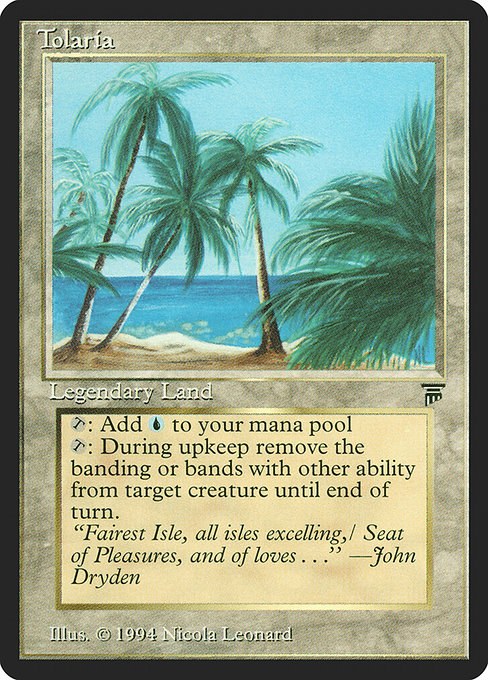
Image courtesy of Scryfall.com
Tolaria: Art, Mechanics, and the Quiet Power of a Blue Isle
There’s something quietly magnetic about a legendary land that never shouts, yet reshapes a game with the mere tilt of a single blue mana symbol. Tolaria, a Legendary Land from the classic Legends set released in 1994, embodies that understated enchantment 🧙♂️. With a {T} to add {U} and a second alerting ability that only dawns during the upkeep, this card is as much about clever timing as it is about mana flow. In the era of big, bombastic spells, Tolaria reminded players that utility and tempo can come from a quiet corner of the battlefield, where a land can both provide blue mana and disrupt an adversary’s symmetry with banding—the old-school combat trick that once complicated every Mildred-in-the-foil debate about who blocks whom ⚔️.
“Fairest Isle, all isles excelling, Seat of Pleasures, and of loves . . .” —John Dryden
Artistically, Tolaria is a window into the blue side of Dominaria’s mosaic. The card’s illustration, crafted by Nicola Leonard, conveys a serene, almost architectural glow that hints at Tolaria’s role as a hub of magical study and discovery. Leonard’s work on early MTG pieces carries a crisp linework and painterly atmosphere that makes the island feel tangible—an education in how color, light, and line can suggest both place and purpose. The flavor text itself, a Dryden allusion, frames Tolaria as a locus of refinement and wonder, inviting players to imagine its academies, libraries, and hidden coves where spellcraft meets strategy 🎨💎.
Artist Spotlight: Nicola Leonard and the Legends Era
Tolaria sits among Nicola Leonard’s notable contributions to the Legends era, a time when Magic’s art frequently combined mythic grandeur with intimate character studies. Leonard’s portrayal of the island land captures the mood of a haven shimmering in blue—calm on the surface, quietly formidable beneath the waterline of gameplay. The work isn’t about overpowering spectacle; it’s about suggestion—the suggestion that Tolaria’s blue mana is a doorway to a larger cognitive map of the game, where timing, tempo, and careful targeting can swing a match as deftly as a flashy counterspell 🔮🔥.
From a design perspective, Tolaria’s two upkeep-tied abilities showcase the period’s fascination with layered interactions. The first ability—{T}: Add {U}—is the purest expression of a land’s function: it simply supplies blue mana. The second ability—{T}: Target creature loses banding and all "bands with other" abilities until end of turn—turns a seemingly simple card into a tactical instrument. It invites players to consider not just what their own board looks like, but how a hostile army arrayed in bands could alter the math of combat. That layering of utility and tempo is part of what makes older legends so beloved by fans who savor the puzzle-box nature of legacy formats 🧩⚔️.
From Card to Culture: Why Tolaria Remains Relevant
Legends era cards like Tolaria carry a particular aura—nostalgia wrapped in a deck-building toolkit. The card’s rarity as an uncommon in a set famed for its bold unveilings makes it a treasured find for collectors who value both memory and mechanism. While Tolaria’s nonfoil print might not scream value the way a flagship mythic would, its historical significance, coupled with a memorable flavor line, ensures it’s frequently spotted in preserved collections and budget-friendly reprints of the Legends era. For players who refine a blue-green or control shell from across the years, Tolaria’s legacy is a reminder that simple mana production paired with a nuanced control tool can still shape the narrative of a match 🔎💡.
In today’s collector conversations, Tolaria is often discussed alongside the broader question of how early art and design choices influence modern MTG aesthetics. Nicola Leonard’s artistry contributes to a lineage of MTG illustrators who defined the mood of early Dominaria, and Tolaria remains a vivid case study in how an illustration can become shorthand for a card’s identity—an image you recognize before you even read the text. That enduring resonance is part of why so many players keep a print of Tolaria nearby, not just for play, but for the memory of an older, more exploratory era of the game 🎲🎨.
For players who want to hold onto a piece of that magic in a contemporary setting, Tolaria’s blue iconography and its signature Dryden flavor-text still spark conversations about how art and rules intersect. It’s a reminder that in Magic, even a humble land can be a mentor—teaching us to consider line of play, timing, and the subtle art of disruption as much as the power of a flashy spell.🧙♂️
Phone Desk Stand Portable 2-Piece Smartphone DisplayFor collectors and players chasing the legacy of blue on Dominaria, Tolaria is a bookmark—marking a moment when a land card could be as strategic as a creature or a counterspell, and when art could invite you to imagine the stories behind the symbols on the battlefield 🧭✨.
More from our network
- https://crypto-acolytes.xyz/blog/post/how-news-shapes-crypto-prices-and-investor-behavior/
- https://blog.digital-vault.xyz/blog/post/mastering-consistent-design-systems-for-scalable-products/
- https://crypto-acolytes.xyz/blog/post/proof-of-work-vs-proof-of-stake-which-is-best/
- https://transparent-paper.shop/blog/post/milky-way-radial-velocities-reveal-a-26-kpc-hot-giant/
- https://transparent-paper.shop/blog/post/choosing-digital-paper-for-wedding-invitation-templates/